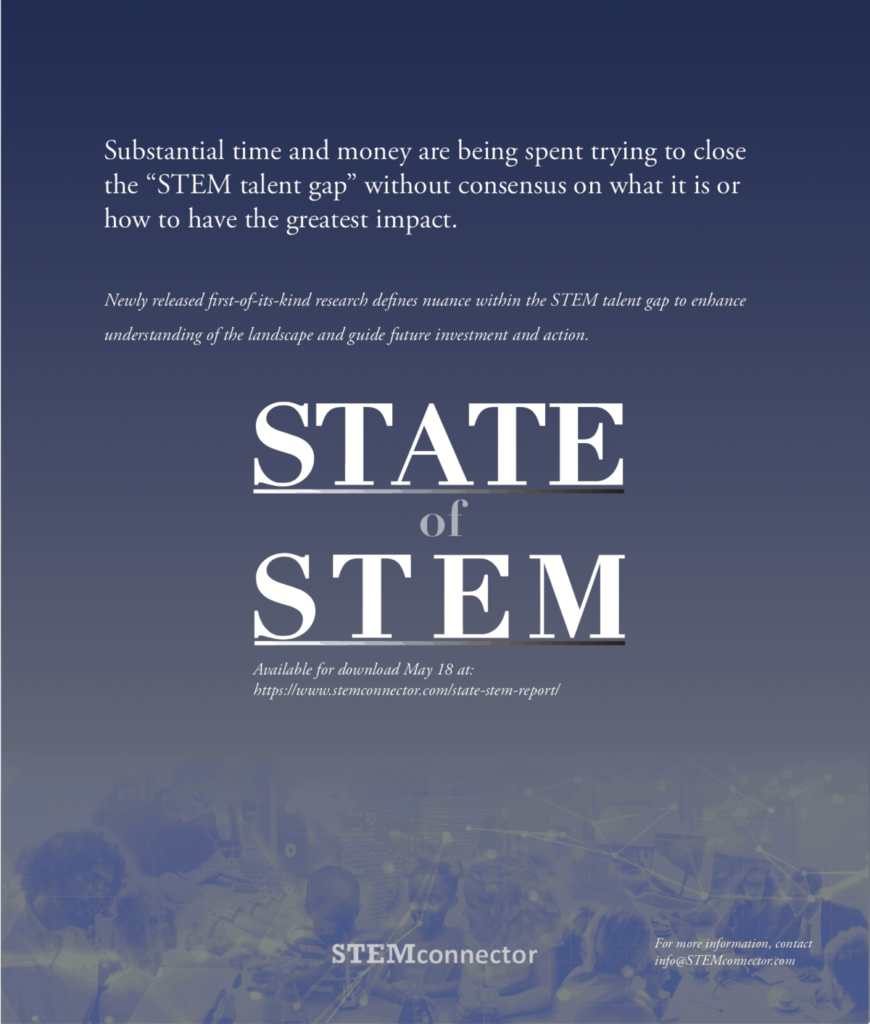WASHINGTON, DC — May 18, 2018 | STEMconnector released new research on the forces and factors that underlie the STEM talent gap, providing direction for further investment by industry, higher education, government, and nonprofits to eliminate barriers to opportunity for individuals across the STEM talent pipeline. The first-of-its kind report, The State of STEM: Defining the Landscape to Determine High-Impact Pathways for the Future Workforce, delivers a comprehensive view of the STEM ecosystem, identifying major players in the space for the purpose of fostering cross-sector collaboration to solve talent challenges.
With as many as 2.4 million STEM jobs predicted to go unfilled by 2025, solving STEM talent challenges is a national, and global, imperative. Industry leaders are looking for insight as to what kind of investments will drive the greatest economic and social impact and ensure competitiveness in the talent market. The State of STEM report examines the confluence of gaps that drive the larger concept of a talent gap, including gaps in fundamental skills, postsecondary pathways, geography, demographics, and self-perception and belief. The report adds nuance to the broader conversation about how to define and address the STEM talent gap, which continues to be a challenge despite years of investment on the part of the industry, government, K-12 education, postsecondary, and philanthropy sectors.
“It was encouraging to learn through this research that employers, educators, and others are generally aligned on an overall goal of STEM talent development- to create and harness both personal and economic opportunity,” said report author Erin White, Senior Director, Product Development & Research at STEMconnector. “State of STEM creates a common framework for action and investment to achieve that common goal.” The report synthesizes learning from over 100 interviews, a literature review of existing research, and was driven by member insight. STEMconnector members comprise cross-sector leaders from organizations seeking meaningful opportunities for impact in developing the future workforce.
The first in a series of releases, the State of STEM report offers recommended areas of focus for practice and investment to address the gaps in STEM talent. Subsequent planned releases include case studies of cross-sector partnerships, white papers focused on specific topics such as building the business case for K-8 STEM investments, and tools to guide investment and practice such as a data bank and an interactive ecosystem map.
“This report, in many ways, puts into words so much of what those of us working on these issues have been struggling with for years,” shared long-time STEMconnector member and Vice President, Cargill BioIndustrials, Jill Zullo. “This report will help me think about which organizations I should be partnering with, and how I should be looking to evaluate those partnerships. Working collectively, we can overcome the gaps in STEM talent.”
The report is available for download at: http://www.stemconnector.com/state-stem-report.
STEMconnector is a professional services firm committed to increasing the number of STEM-ready workers in the global talent pool. Owned by Diversified Search, LLC, we provide a platform to engage leaders in both public and private sectors who collectively are re-envisioning the workforce. Working with pioneering leaders across over 200 organizations, our overall goal is to inform, stimulate and connect leaders with a passion for and vested interest in growing a STEM-ready workforce. STEMconnector is committed to a networked-approach because we believe that no one sector has a monopoly. This guiding principle is reinforced by the breadth of our network that represents 25+ million students, 3.5+ million educators and 2.6 million STEM jobs. We are excited to work with Heads of Talent Acquisition, Chief Diversity Officers, CIOs and CTOs at leading corporations. We count Presidents of 2-year and 4-year universities as well as Executives of NGOs within our network. Most organizations who try to tackle the STEM gap independently found it difficult to deliver broad impact across a large population. By combining resources, ideas and energy across private and public sectors, members have realized they can collectively drive much more sustainable change and improve their talent pipelines than when they try to tackle it alone.
